Managing Hedera Helix (English Ivy)
By and large it is the people who don't have English Ivy on account of their own doing that loathe it. And it is those who intentionally grow it who love it. I am of the latter and starting this thread in the hopes of helping some of the loathers, especially those who live by the lovers (I know there are many!) accept and maybe even come to appreciate this workhorse plant, as I do. Truly, English ivy has many good features, some of which make it the BEST plant to solve many landscape problems. I know of nothing else that grows so well in dry shade, on difficult terrain, with so little attention and can look all the while magnificent. As a landscape architect, I once toyed with the question of, "If one were relegated to a single plant from which to make a landscape ... what plant could they use?" After some pondering I concluded that English would not only be the best plant, it would probably be the ONLY plant that could satisfy this quirky mental exercise.
I've heard it said many times that English ivy (which we can refer to as just, ivy) cannot be managed. But as a person who has grown it in two of their own yards -- in plots of approximately 1/4 acre each-- and managed multi-acre tracts of it (collectively) when I worked as a grounds manager of a large southern university, I know for a fact that it is entirely manageable. One only needs to use tools and techniques that are simple and effective and discard incompetent methods that don't work. Let's not swim against the tide!
For clarification, we are NOT talking about ivy other than Hedera helix .... not Algerian, Boston or any others. I don't want someone thinking that all maintenance methods apply universally to other plants/ivies and claim failure based on that misconception.
Some of ivy's positive attributes are that it:
- is evergreen
- is relatively low -- 8" on the crawl
- does not require mowing
- able to survive with very little water once established
- is suitable for large urban areas, up to multi-acres
- can be confined to relatively small areas (100 S.F.)
- comes in different forms (needlepoint ivy) that are suited for smaller areas
- is tolerant of abuse
- tolerates wide latitude of light from deep shade to near full sun
- can be walked on without suffering damage
- is very inexpensive
- can be started in mass quantities without special skill or equipment
- is generally unaffected by diseases and insects
- is capable of growing in wide latitude of climates
- controls erosion in difficult situations
- capable of transforming appearance of harsh, rough terrain into smooth, green scenery
- can cling to vertical hard surfaces if desired
- can cascade downward if desired
- is the flattest, thinnest evergreen plant that can be trained on a chain link fence.
- low to no supplemental fertilization requirements
- can be prevented from producing seed if on one's own property.
- harmless to trees
- "absorbs" large quantities of fallen leaves without the need for raking.
There are more positive attributes, I'm sure, and maybe some of them will become evident during the discussion.
This thread is NOT for those who wish to reaffirm and voice how evil they think this plant is. There are a thousand other threads where that can be said and has probably already been said. THIS is a thread that seeks to make it easier for those who find themselves living in close proximity to the plant, or with it, and feel frustrated by their inability to have the upper hand in getting along with it. Let's talk about how to manage it!'
For the vast bulk of its utility to man, ivy is a ground covering, whose height is self limited by genetics to approximately 8" (this could vary with geography but in Atlanta, Ga, which is where I know it, it's 8"). It demands no top cutting though it can be cut if one wishes to refresh its top growth. It is only the leading growth at the ivy plot boundary edges that must be dealt with as a routine maintenance chore. Compared to a grass lawn -- whose entire top surface must be cut weekly ... and edged! -- ivy requires less attention. The advancing edges grow approximately 3' during the spring and summer growing season. (In effect, if a person could tolerate that growth, they could trim their ivy edges once per year and be done with it.) These edges meet a variety of landscape elements: pavement, lawn, fences, walls, alleys, trees, etc. and must be dealt with in some way so as not to overrun the other element. There is not a single method that works in all cases. One must use a variety of methods in order to be effective. One must also make a determination as to tolerances that are allowable. There may be areas that need to be maintained with a razor sharp edge and other areas where allowing longer growth or being less tidy is OK. Often, it's somewhere in the middle. Commonly, I see that many people don't address the growth for years (or maybe ever!) and they seem to be some of the ones that can't wait to vocalize how unmanageable ivy is!
As long as the thread is active, I hope people will ask questions about their specific situations until all typical conditions that one might meet are dealt with. To start with, let's address what to do where ivy meets a turf lawn. Here, there are options because people have different tolerances of what they will accept and different degrees of work that they are willing to perform. If one wants a crisp definition to both lawn and ivy, they're going to need a mowing strip. This is a hard, flush laid row/strip of brick, concrete, pavers or similar (like a narrow walk), usually 8" or wider, that divides the turf from the ivy. The strip give the lawn mower wheels an edge to ride on and acts as a permanent marker of where bed edges are. And it give an edger something to cut against for clear definition to the bed edge. But it's not the easiest way.
The most common way of edging ivy where it meets lawn is with a by-product of the mowing operation itself. Let the mower cut the edge of ivy that has any height to it. Since the ivy edge is attached to a mature root system, the ivy continues to grow out into the lawn. But since it is cut weekly, its leading edge cannot develop additional strength to continue the march onward. It grows new leaves, but they are small, short, mixed into the turf and not visible from a distance. And the longer the stems grow into the turf, the shorter and smaller the leaves become. At about 3' it can't go any more and gives up. The vast majority of instances where ivy meets turf are dealt with this way and it amounts to this particular edge of ivy requiring NO maintenance at all! The lawn is mowed and the ivy is maintained without any additional work whatsoever.
Another condition that seems to aggravate loathers is where ivy meets trees and grows on them. First, if ivy is left it to its own devices, it only grows on the stout wood of trees (trunk and major limbs). It does not grow on any extremities. It remains at the interior of trees, within the canopy "shell" so does not shade out leaves and rob the tree of its light energy source. Too, ivy stems grow more or less vertically on the trunks. They do not coil and wrap around them so are not responsible for "strangling" them. If one likes all that green ivy on trees (it can be quite attractive on deciduous trees in the winter time) they can simply do nothing.
But if one wants their trees clean and clear of ivy, all they need to do is snip the vines low on the tree once per year. Since the leading edges advance at 3' per year, if they are cut at annual intervals, 3' is the highest they can get on the tree, which is inconsequential. There will be a finite amount of vines that will grow on a given tree, with the number depending on the diameter of the tree trunk. On a typical large tree it might be in the teens or up to 20. It literally takes 2 minutes with a sharp blade -- which could be an ax, machete, hand pruners, pruning saw or whatever one like best -- to cut fresh growth vines on a good size tree. A single cut per stem and the job is done. Under no circumstances should one try to remove the ivy that has grown up the tree trunk. It will be held fast and nearly impossible to remove. Instead, walk away. In a few days the leaves will fall off, sifting down into their living relatives where they are completely out of sight. In a few short weeks the stems will follow. It is literally less than a 1/2 hour job to keep ivy from growing onto a dozen large trees -- once per year!
(We are not getting remotely close to the kind of time maintaining a lawn would require.)
To b continued...
Comments (51)
gardengal48 (PNW Z8/9)
5 years agoManaging English ivy in areas where it is not considered an invasive species is fine. Although you DO need to keep up with it. And that's the major problem with growing ivy in areas where it IS considered invasive (pretty much anywhere along the west coast, as well as selected east coast locations and much of the southeast). While the original gardener that plants it may be able to keep up, there is no guarantee that subsequent homeowners and gardeners will do the same. In fact, it is pretty much a given they will not!!
Removal of English ivy from natural areas (forests and greenbelts) as well as public parks eats up 100's of thousands of tax dollars here in the PNW that could be better spent on other public works. As well as involving vast armies of volunteers for removal work parties. And besides being a major invasive species and extremely difficult to control and remove, an established planting of ivy is an extremely desirable habitat for rodents. Do you really want a colony of rats living in your yard?
Sorry, Yard, but I could never in good conscience recommend planting English ivy in the ground. It is not even allowed to be sold here as a groundcover (only the more decorative or fancy leaf forms as houseplants or container plants).
Yardvaark
Original Author5 years agolast modified: 5 years agoiF ONE DOESN'T HAVE OR WANT IVY AND THE NEIGHBOR'S IVY IS GROWING OVER THE PROPERTY LINE, it will depend what is at one's own side of the line as to how one will deal with it. If one has lawn, then it can be managed the same as what one would do for one's own ivy meeting one's own lawn, described previously. If the neighbor's ivy is meeting paving, mulch or landscape bed of other plant material, then mechanical cutting -- "edging" -- is the preferred method of dealing with it, if it needs to look tidy.
Ivy might be growing a little over 2" per week. But this is very tender growth and is easily taken off if done regularly (every week) with a string trimmer. If it done less regularly -- every two, three or four weeks -- then it is hardened up somewhat and probably better to use a steel bladed mechanical edger. If it is in an area that doesn't need to look especially tidy, at an alleyway for example, then one could spray a narrow band of the encroaching ivy with any broadleaf weed killer. glyphosate (Round-Up) and 2,4-d (Weed-B-Gone) are examples of two commonly available products. The sprayed portion will brown, the leaves will shortly after fall off and the stems will remain and degrade over time. Again, this is for an area where appearance isn't necessarily important.
If it's a situation where one doesn't wish to use herbicide and a mechanical edger cannot be used because of tight space or difficult terrain, then another possibility is to manually cut the advancing edge with a SHARP, square blade (flat) spade. This is a little more work, but if that's what one's policies determine, then that's the consequence one must accept. It is very important that the spade be sharp. Sharpening can be done on a regular shop bench grinder, which is a relatively inexpensive piece of equipment. The spade is used as one would chop off the tops of carrots on a cutting board. If one lets the ivy advance beyond one month of growth, then they are going to have a bigger job as it will be rooting into the underlying soil such that severing it from the source will not cause its death. It will need to be removed from the soil. Scraping it up with a hard tine rake will take care of that.
If there is a fence that divides the property and ivy is coming over or under, it will depend on who owns the fence as to how it is dealt with. If the neighbor owns the fence, then one can only deal with what comes onto their side of it. What comes from the ground can be dealt with in the same manner as described just previous: mechanical cutting, or spraying a swath of herbicide along the ground at the fence back side. If it is coming over the top, the main consideration is that it doesn't reach the ground on one's side of the property and begin to root there. Cutting it by hand probably just once per year is enough to keep this from happening. If it has started attaching to the fence, it must be severed somewhere near the fence top. If it is well attached and difficult to remove, leave it. The leaves will fall off shortly and a little later the stems will follow. They can be cleaned up as they accumulate. If one has plantings that hide them, the fallen debris can be left, if desired.
As an alternative, depending on what one has on their own side of the fence, a person could be better off if they allow the ivy bed on to their side and cultivate its edge completely on their property. An example might be if one has a stand of trees & a lot of shade where no turf lawn grows well and one needs groundcover anyway. In my opinion it would be a serious mistake to need groundcover along the lot line and choose a different type IF ivy is growing directly adjacent. In that case accept the ivy and make the maintenance easier by determining where its advancing edge is on one's own property.
Related Discussions
English Ivy (Hedera helix) juvenile form
Q
Comments (7)I'm certainly not qualified to distinguish the difference ... http://www.gardenguides.com/129436-baltic-vs-english-ivy.html As commented in a 1932 publication from the Arnold Arboretum, there is little physical visual difference among the wild form of English ivy with Baltic Ivy. Perhaps the key distinguishing features, according to that document and the American Horticultural Society's "A-Z Encyclopedia of Garden Plants," is that Baltic ivy's leaves are slightly more heart-shaped and have noticeable white veins. http://www.greenwoodnursery.com/page.cfm/30690 Baltic Ivy, Hedera Helix Baltica, is a delightful evergreen Ivy that has smaller leaves then the English Ivy but still a deep green color with interesting white veins. http://classygroundcovers.com/item--Hedera-helix-Baltica-%7B50-Bare-Root-plants%7D-Baltic-Ivy--197 Hedera helix 'Baltica' is an aggressive, fast-growing, evergreen, woody perennial self-clinging or trailing vine with 3- to 5-lobed, glossy leaves that are unusually dark green with prominent white veins. This variety of English Ivy is very similar to Hedera helix, except its dark green leaves are more white-veined, smaller and purplish-tinged in winter....See MoreHedera Ivy Plant
Q
Comments (7)All English ivy is in the Hedera genus, helix is the species & there are hundreds, if not thousands, of varieties (or cultivars, if you prefer) of Hedera helix. They are very nice outdoors in a pot where they appreciate shade from at least the midday sun & evenly moist & rich soil. They like a fertilizer with high nitrogen in summer & you can solve the common winter mite problem by overwintering in an attached garage. Linda is right about dieback in zone 5 where it is marginally hardy. Al...See MoreHow renew mats of Hedera helix?
Q
Comments (1)English ivy (Hedera helix cultivars) are extremely tenacious plants, to the point of being invasive in many parts of the country. They will freely regenerate from just the root system in areas where they are fully hardy....See MoreIs something wrong with my hedera helix?
Q
Comments (2)right now it is i guess. But later i will pot it into a bigger pot for my balcony....See MoreYardvaark
Original Author5 years agolast modified: 5 years agoIn general, it's a good idea to KEEP IVY OFF OF STRUCTURES SUCH AS FENCES, WALLS OR BUILDINGS, especially if they are made of wood, or if one doesn't want them blemished by rootlets that would remain even when ivy stems and leaves are removed. These small rootlets could take months or years to decay on their own. If ivy is already growing on such structures, the way to remove it is the same as the method used for when ivy climbs trees: snip near the ground and then let the leaves and stems fall off on their own. It would not be possible to remove the remaining tiny rootlets except by some type of manual grinding process which is likely to damage the structure surface. Pressure washing will not remove them. It is best to leave and ignore them. If one must paint, paint over them.
It is OK to allow ivy to grow on a solid masonry wall, such as a poured concrete wall, but keep in mind that if later it is decided to clear the wall of ivy, it will not be possible to remove the small ivy rootlets. They will be hold fast and tight to the wall surface. Ivy could be grown on a mortared wall only if the mortar is in good, tight conditions. If it is aged and "soft" or has hairline fissures, it is best to keep ivy off of it.
The easiest method of keeping ivy off of a wall is to spray its advancing edge in a one-foot wide swath with herbicide (glysophate, 2,4-d or both in combination), mixed at their strong regular rates. If the ivy already exists and is mature, it may require repeated sprayings at intervals until the one-foot wide "DMZ" is cleared of mature plant. Alternatively, the "DMZ can be cut and manually removed by any method one favors. Once it is cleared of mature plant, it can be sprayed or mechanically cut once monthly which is usually about 4 or so times per season.
Yardvaark
Original Author5 years agoWithout question, ONE OF THE GREATEST ADVANTAGES OF HAVING IVY IS AN END TO RAKING LEAVES IN THAT PORTION OF THE YARD! There is simply no need to do this so long as the leaves sift down into the ivy which is the case in most instances. There may be some large leaves (such as Sycamore) that have a tendency to sit on top of the ivy and those would be an exception; they may need to be blown off. (I'm not sure if they will sift down into the ivy, or not, because I never had this condition.) But smaller leaves will present no problem, disappearing below the ivy surface and turning into mulch and decomposing over the next several months. By the following Fall, ivy is ready to accept a new batch of freshly fallen leaves. In my case, I had a small lawn adjacent to the ivy field. I was able to blow leaves from the lawn into the ivy, making sure that they sifted down into it as opposed to sitting on top. This means keep blowing in farther until they are "gone."
I have heard some detractors of ivy complain of how hard it is to rake leaves out of ivy! Why would one ever do this ...?? It makes no sense to remove something that is vastly less work and simultaneously improving the soil if left alone.
Yardvaark
Original Author5 years agolast modified: 5 years agoIf there is existing ivy along any common boundary of an adjacent neighbor's yard, it is futile to also need a groundcover and not let it be ivy as well. It is very difficult to keep two groundcovers from intermixing if either one of them spread laterally, which ivy does and most others do, too, and there is not a hard, wide, well maintained edge barrier between the two. It is better to give up the idea of a having a separate groundcover. Instead, use the ivy and like it for all the advantages it has to offer and commit to learning how to manage it. Life will be so much easier! In this situation one could also be grateful for how they are getting either a free or low cost groundcover.
After committing to this plant, one may discover the need to produce more of it if they are expanding or creating a groundcover area. The good news is that more ivy can be created very easily by people with no other horticultural experience. It roots quickly and easily and can be more or less ignored during the process. An easy method I've used many times requires first finding a good spot that is shaded, but light and open to the sky. This could be the north side of a building or place in a semi wooded area that is not too shady. Some light is needed because it is the plant's energy source. But direct sunlight is hot and drying so will destroy cuttings before they have a chance to grow. The medium I like to use is fine ground pine bark .... sold as Pine Bark Mulch in many places (not nuggets -- which are large.) Its pieces are flat, about 5/8" spread and smaller, down to dust. The particle sizes allow it to stay moist for a length of time. One simply spreads out a 4" thick layer of bark over the amount of area proportionate to the number of cuttings they are producing. Farthest away from where one is positioned (in front of the pine bark) create furrow along the back side. Install cuttings in this furrow about 1" apart. It will be as if planting a row of corn. When the row is finished being planted, cover the base of the cuttings with at least 3" of bark material and then create a new furrow in front of and near the last row ... such like one would be planting a second row of corn. Continue on like this until all are planted and then water the whole mass of cuttings at the end. Then play farmer and watch the crops to make sure that they don't dry out. Water as necessary which will be daily or every other day if no rain.
After 3 or 4 few weeks, check the cuttings by giving a minuscule tug on a few of their tops. If it is loose in the medium, it has no roots. If it resists, they are forming or have formed. Dig a plant out and check the progress visually. If there's a good stand of roots about 3/4" or longer, they are ready to be planted in their permanent location. Do not wait too long then as, if the roots grow too much, they will begin to grow together and it will be a time consuming mess to separate them.
To make cuttings, first remove the bottom 3" of leaves from the stems. It is extremely helpful to treat cuttings with rooting hormone just prior to rooting them. The easiest way is to dunk the cuttings in water and set them on a work table. Then, one by one, dip their bottom end into the rooting hormone powder about 2". Because the stems are wet, they will hold the powder. Tap the excess back into the powder container. Be careful not to scrape or knock off the powder (except for excess) while transporting cuttings to the rooting area or while installing them.
With 12 cuttings per foot of row and rows 2" apart, one could create approximately 100 rooted ivy cuttings in approximately 1 1/2 square feet. Later, when they are planted, I suggest 12" apart in the row, and in rows 12" apart. That is one plant per square foot. 1 1/2 square feet of cuttings turns into 100 square feet of groundcover which is an easy way to get a lot of plants cheap. If one is doing this early enough in the season, they can achieve a nearly solid groundcover by the end of summer. The first 4-6 weeks are required for the rooting process and then the rest of the summer the rooted cuttings are growing in their permanent position. The key to their fast growth will be fertilizer (like the same as one would apply to a lawn ... with NO herbicides incorporated) AND WATER. Regular, frequent watering will make all the difference in the world once plants are installed. Three times per week is great, but twice will suffice if need be. Once is not enough.
Let's suppose that one has no ivy of their own as a source for cuttings. In my case, while I had ivy, several times I did not have any that I wished to give up in order to make cuttings. However, I was surrounded with a metro Atlanta area that was burgeoning with overgrowing ivy and also with a lot of homeowners who were lax about trimming it. By far, the best source of ivy cuttings is from growth that occurs in some sun (it is more vigorous) and that also happens to be along the edge of a paved area. Why? Because all of this growth is growing straight outward from the ivy mass. Therefore, it is perfectly aligned, each plant parallel to the next. It is much easier to work with if it is organized like this. When dipping into the rooting powder it is easiest to set up a production line-like affair where all stems are oriented in the same direction. Keep them like oriented that way all the way through the planting process and it will be much quicker. The ideal cutting length is 8". Therefore, one only needs to drive around hunting until they see someone who has ivy overgrowing the sidewalk by at least 8". And then offer to trim it! I've done this a few times, whenever I needed more ivy, and have never had a homeowner turn me down. Of course, no homeowner is going to like a person trimming 15' of their 30' walk and leaving the remainder of ivy untrimmed. Therefore, one needs to find the run of ivy nearest the amount they require, or cut the extra, take it home and throw it on the compost heap. It does not take long at all to cut several feet of leading edge fresh growth ivy, either with hand pruners or a sharp square blade spade. I would caution one against arranging with a homeowner ".... next time you cut your ivy, can I have the trimmings?" They will say yes, but one would receive a garbage heap of mismatched sizes dumped into a pile like pickup sticks. It will take more time to sort it all out and make it right, unless one is desperate for a source.
Yardvaark
Original Author5 years agolast modified: 5 years agoIf you have a question about ivy that I haven't covered, ask it in a post.
josephene_gw
5 years agoThanks Yard. Good reading.
I like ivy too. Grows well here in the high desert.
jo
Yardvaark
Original Author5 years agoI don't monitor this post much so missed Gardengal's post from back in June. Addressing it here...
"Removal of English ivy from natural areas (forests and greenbelts) as well as public parks eats up 100's of thousands of tax dollars here in the PNW..."
If the result is not lasting removal but ongoing battle, then the effort may be a complete waste of taxpayer money. People would be better off learning to manage ivy rather than spinning their wheels trying to eradicate it. As with other government programs that don't achieve success, often the real motivation for people that head or man them is simply as a way of tapping into a source of easy money or jobs.
"... ivy is an extremely desirable habitat for rodents. Do you really want a colony of rats living in your yard?"
As far as English ivy being a habitat for rats, we have to acknowledge some truths about information. Most landscape information does not come from scientific experiments, but is the result of anecdotal information -- stories that are passed on ad infinitum. Like you, I've been in the horticulture and landscape profession most of my adult life. I've seen first hand how misinformation can be promoted and perpetuated, sometimes by the industry if it is generating money. Another driving force that perpetuates information is fear. People who hate snakes wish that everyone would hate them. People who hate ivy wish that everyone else would hate it, too. I reject the rat habitat based on logic and wouldn't consider changing my mind until scientific evidence shows otherwise. Ivy is not a food source for rats so wouldn't attract them on the account. Is it a shelter for them? In a groomed yard it wouldn't be because in that situation, ivy doesn't offer any overhead protection other than a single layer veil of leaves. In a neglected yard, ivy might be growing over a pile of debris and in that situation tends to "knot up" and might be capable of sheltering a rat. However, this is not different from a thick growth of any type of plants. It is not its being ivy, per se, that it the attractant. It is that the foliage thickness offers shelter. Rats will use whatever is available. There is no evidence that they seek out Hedera helix specifically.
Where I'm most familiar with English ivy is in the Atlanta area. During the time I was there, everyone knew of ivy's propensity to "take over" (as some would describe it) a shaded area. But "taking over" in a dry shade situation where groundcover is needed to prevent erosion, and where beautification is desired, is not bad thing. This is ivy's forte -- controlling erosion where the runner up alternative is almost always a collection of uncontrollable and unattractive weeds. I heard some people there groaning about ivy being difficult to control. But upon questioning them, I assessed that these were also the people that had little knowledge of controlling plants in general. They didn't know methods or have proper equipment and had little interest in outdoor work. Worse, they sought out the opinions of other inexperienced people like themselves in order have their predisposed negative ideas about ivy confirmed. They wanted to hear what they already believed. And once enough of them believed, as many modern day Americans do, they wished to have their ideas forced on everyone else. The problem for me is that, since I've successfully managed a cumulative total of many acres of ivy, I KNOW for a fact and without a doubt that it CAN be managed without the great difficulty that so many cry about. Why would I stand by saying nothing when I see people with the greatest lack of knowledge about ivy or managing it, try to force their way on everyone else? I think it is they who should educate themselves and start doing a better job learning to control plants that happen to be incredibly useful, especially when all accounts have it that ivy is there to stay.gardengal48 (PNW Z8/9)
5 years agoI am not going to argue with you. It is extremely well established that English ivy is a serious invasive issue across many parts of the US. And where it is it should not be planted, anymore than any other aggressive spreading invasive species. That is just gardening responsibly.
It is also true that that subsequent homeowners may not "manage" this plant in the manner necessary to keep it in bounds. I too have lived with already planted and well established stands of EI and it is not any sort of easy-peasy thing to keep in check if it has been allowed to run rampant. And I see it on a daily basis where it is in the same situation and now has consumed wide swaths of the landscape (not even including its forays into natural areas where no one "manages" it)!!
As to the rats, it is a hugely common problem, or at least it is here on the west coast. I have personally witnessed scores of rats departing an established stand of ivy when it was hit with a brush hog. And you can find a lot of documentation recommending clearing properties of ivy if rats are a problem. They don't eat it but they do live in it, creating a dense network of tunnels and nests. An established stand of ivy can be several feet thick, providing more than enough cover!
I have to say I find it rather bizarre that a landscape professional would sing the praises of what is considered a major invasive problem in all but the coldest climates. This just does not compute for me.
Yardvaark
Original Author5 years agoI sing the praises of ivy not only because it is beautiful and durable, but because it is incredibly useful, solving erosion control problems that can't easily be solved in other ways. I am not so much as an advocate of planting it anew as I am of learning to manage it where it exists ... in lieu of throwing one's hands up in the air exclaiming the impossibility of the situation. As far as I'm concerned people can make their own decision as to if ivy works for them, or if there is something better.
Our differences, Gardengal, are probably going to boil down to what we believe are the true facts. You believe ivy brings rats and I don't. I think there is a 3rd or 4th component in that mix -- debris, neglect. In a neglected, wild area, it could be any ground dwelling animal that thinks a debris pile covered in ivy makes a nice home. In an earlier discussion people made claims about ivy turning into fortress-like structures and it turned out they were talking about Algerian ivy, lumping it with English ivy as if they were the same. If I was to change my mind about ivy, it would be based on scientific, not anecdotal evidence.
Since this is not our first discussion about this subject and we seem to be on polar opposite sides, I'm thinking that talking about it is going to be like talking about Global Cooling .... I mean Warming ... I mean Climate Change. Some people think that Al Gore is a savior. Others think he is a hypocritical, lying, pompous buffoon. Climate Change alarmists insist that the entire world agree with them and make sacrifices that others see as highly destructive. They see it as the fraud of the century -- a way for schemers to get their hands on the billions of dollars that are collected from sacrificing taxpayers and given away by the government. It will probably be time and empirical evidence that determines what people decide about it in the future. With ivy, I've personally seen so many people throw up their hands in despair, saying it can't be managed. But they won't take the first suggestion and attempt to do it. With that reaction, how can anyone give weight and credence to their position? I see them as naysayers who are creating their own doom.
kitasei
5 years agoOK, I inherited a lot of ivy on my property (which has thrived since installing a deer fence) so I have some questions for you. (1) What's the best way to keep an ivy ground cover from overtaking shrubs and small trees? (2) I have ivy in the same area as ajuga and creeping euonymus. Will the ivy win? (saving me the effort of trying to get rid of the others) (3) I have planted some sturdy perennials like peonies at the outskirts of an ivy island. Is this going to work? What successfully competes with it? (4) What bulbs work best with ivy? (5) Can I safely dump all the trimmings into my cold compost piles, without fear of them rooting and taking over the nearby woods?
Thanks!
Yardvaark
Original Author5 years agoKitasei, at any tree you don't want ivy to grow up, cut the ivy at the base of the tree at least once per year. It i not necessary to remove the attached stems. The leaves will fall off soon making it much less visible, and within a few short weeks, the stems will fall off and be hidden by what ivy remains growing at the ground. For shrubs, it's a bit more of a pain. You need to cut the ivy at the outside footprint of the shrub with a sharp spade, stabbing in the ground around the shrub perimeter. Pull out what ivy grows below the shrub. If the shrubs are not highly visible in the landscape, you could spray a 12" ring of glyphosate at their perimeter (very carefully ... I always use a fan tip on a backpack sprayer which will spray a knife edge) so as to greatly slow the advance of ivy into the shrubs space.
It's usually difficult to impossible to keep groundcovers apart. It's better to designate a single groundcover for a given area, and have some separation, probably hardscape of some kind, like paving or walls or such, between them. Ivy would probably win over ajuga and Euonymous in a competition, but they're both going to look messy and unkempt where mixing. While ivy would likely win ultimately, I wouldn't leave it for those plants to have a big fight because it's going to be ugly for a while. Too long.
Yes, you can put ivy cuttings in the compost as they will die in not too long.
It doesn't sound like a great looking idea, to me, to put peonies at the outer edge of ivy though this will probably physically work out without great trouble. (I'm speculating, because I never lived where peonies would grow when I had ivy.) So long as the peonies are getting enough light, at least once per year you're going to get fresh peony foliage and be able to sort them out that way.
I think the best bulbs to grow in ivy are daffodils. When their foliage dies down it is automatically hidden by ivy. And they are a good height to bloom well above the ivy.
kitasei
5 years agoThank you. On the whole it seems like vinca is a more manageable groundcover for a shrub bed than ivy.
Yardvaark
Original Author5 years agoKathy, I saw your post (linked above) some time in the past. I just put a "like" on it. Where I had ivy was Atlanta. We got enough rain that ivy didn't get that the dusty, dirty look, so I never felt the need to mow it even once per year. As new leaves came out, the old would wither and shrink below and decay out sight. However, a dirty plant is not the plant's fault; it's the conditions. Any plant with long lasting leaves would look dusty if rains are sparse.
mbbrown3
4 years agoYardvaark so what is your opinion on English Ivy growing up Pine, Oak and Poplar trees? Our new house backs to a natural area which has some ivy that appears to have been growing up these trees for quite some time, the Ivy is not in the canopy of the trees but has grown fairly high up the trunks and eventually I assume will reach the canopies.
I like the look of it but I also don't want to have extra risk in these trees dying/ falling prematurely.
What is the recommendation? I will try to snap a photo if that helpsYardvaark
Original Author4 years agoMbbrown3, I am trusting that you have correctly identified the plants you are talking about as English ivy -- Hedera helix -- as it is the only plant I am talking about.
That ivy is a tree killer is the predominant false claim made about it by the pro-native, anti-exotic plant, and doomsday crowd. It is not a tree killer because it neither coils around tree trunks, but grows vertically on them, nor does it ever grow on any but the stout wood, never covering the canopy or stopping the trees process of photosynthesizing light into growth energy. There are countless examples of ivy co-existing with trees in forests where the trees remain healthy and happy for decades and centuries. However, in one's own yard, there is a reason not to like foliage hanging low on trees, as it can consume too much yard space and obstruct views that are below the tree canopy. For this reason, ivy foliage growing big but low on a tree may be undesirable. So there is nothing wrong with deciding NOT to have it growing on trees in one's yard. In my own yard I kept it off of most trees and allowed it on a tree or two near the yard perimeter. If ivy grows up trees it will also flower (nothing special) and produce seeds. Keeping seeds away could be another justification for not letting it grow up trees.
If one wants to keep it off of trees, as a routine maintenance chore, simply sever its stems near the ground once per year (a 2-minute job with a blade or hand pruners) is all it takes to enforce this action. Do not bother removing the severed foliage as it will drop off on its own. (If ivy has been let grow up trees for a long time, it will develop trunks which must be sawn through in order to stop the upward growth. This might take a few minutes with a sharp folding pruning saw. Still, no need to remove the severed stems and foliage.)
It is a fact of life that trees, like all animals, eventually do die. When a tree in a natural area dies, it falls over, where the process of decay is speeded up. If the tree is covered in ivy and dies, the same thing happens. It falls over and continues to decay. But it is not the ivy that killed it. The cause of death is whatever disease or old age would have caused its death anyway, with no help from ivy. However, because ivy can become sizable and offers wind resistance, a dead tree might fall over earlier than it would otherwise have, on account of wind pushing on it. But the ultimate fate of death and decay is exactly the same, with or without ivy.
mbbrown3
4 years agoThe trees that have ivy growing on them are in a natural area that is on the outskirts of my yard. Not technically my property but part of a natural wooded area that borders my backyard I will take photos tonight and post them and that way hopefully you can help me identify the ivy and also your opinion on these trees and if anything should be done.
Thanks!
mbbrown3
4 years agoYardvaark, below are some pics of the ivy on trees that I was referring to, again these are actually beyond my fence in a natural wooded area. The ivy is also covering my chain link fence which I like the look of but that is as far as it Is coming into my yard currently
Let me know now your thought on if this is English ivy and if it’s fine to just let it be i am located in Raleigh, NC btw
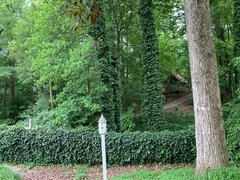

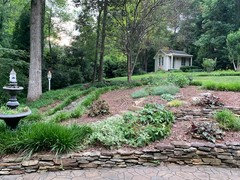
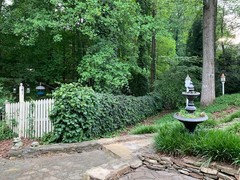

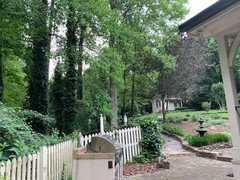
Yardvaark
Original Author4 years agoIt is definitely English ivy.
The ivy is not going to hurt the tree by climbing on them, but it is going to go to seed, meaning that you'll need to remove any that sprouts in your yard that the birds spread, just like any weed. If the natural area is such that you are able to maintain its edge, and wish to do so, it would not be difficult to stop the ivy from climbing the trees, by severing its stems at their base and letting the dead ivy fall over the course of a few weeks. Of course, sawing through ivy trunks the first time would be a little work, but after that, for the ongoing annual maintenance, it would be quick and easy as the new growth would be young and small.
The chain link fence will withstand ivy for many years before it succumbs to rust and old age. But the wood fence will succumb to it quicker. Ivy and wood it grows on do not get along well, mainly because the ivy keeps the wood from drying out quickly after a rain.
When ivy is growing around you, on someone else's property, it is 100% futile to think that you will not need to manage it. Allowing it to be at the edge is fine. The easiest way to deal with it there is to maintain a strip of ground along your property perimeter where you kill any new ivy growth that enters the kills strip zone with glyphosate, such as Round-Up. (I could not imagine caring for a large yard without having a good backpack sprayer, and I recommend a fan spray tip, not a round tip, for precision control.) If you do not halt advancing growth with herbicide, the only other option is to cut it manually, and that's a good bit more work. A sharpened heavy, nurseryman's spade will work well for cutting the advancing edge of ivy, when stabbed in the ground repeatedly along a line. This is quick but must be done monthly or the ivy will toughen and make the job harder.
For the most part, the work involved in caring for ivy is stopping its growth along its edges. One needs to arrange the edges so that they are easy to care. This could be at their edge of their property (such as in a kill strip I already mentioned.) If there are parts of one's yard that need groundcover and are contiguous with neighboring ivy, the ivy could be let in to use in one's own yard ... and then the edge that must be maintained the same as on one's own property, where it would be maintained by a kill strip, mowing, or manual cutting, depending on what works best for the surroundings. Where ivy is on both sides of a property line, there is no maintenance to it at all, unless there is a fence to keep it off of. (Which is also easy to do by spraying with herbicide if one decides to do it.)
mbbrown3
4 years agoYardvaark,
Thank you for the absolutely great information and advice.
I guess my last question would be if this was your property how would you go about this.Would you just maintain this ivy and leave it as is up to and on the chain link fence and prevent it from coming in any further into the yard? Leaving it to spread and do as is on the trees and in the natural area?
Thanks!Yardvaark
Original Author4 years agoMore or less, I would do as you're doing, let it grow on the CL fence and keep it off of the wood one. I would be fine with it growing up the trees in the neighboring property, except and unless, it grew up trees immediately adjacent to the property line. In the beginning of its growing up the trees it would be in the juvenile form, fairly close to the trunk. But eventually, it would transform into the adult stage where it develops outreaching branches that can extend several feet. And It would flower. I wouldn't want those outreaching branches hanging over my property. No huge bad things would happen, but it's closer than I would want some ominous looking "creature" seeming to loom over my property line.
One thing I would do differently is to let the ivy be the groundcover in the portion of my yard abutting the natural area (outlined in yellow.) There I would get rid of the other groundcover and the Liriope, using those plants at other areas. There would still be only edge of ivy to look after, but not two different groundcovers to keep apart. I would keep it off of the trees in my yard, OR possibly let it grow up the larger tree to 4' height as a skirt. (It looks quite good like that.)
BTW, I'm not a fan of Liriope as an edging, especially when the plant it is surrounding is lower height than it. It looks better to let whatever plant be its own edging and use the Liriope as a solid groundcover in its own area.
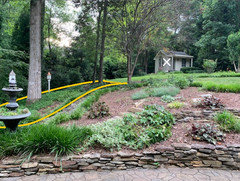
mbbrown3
4 years agoThanks, I may consider cutting the ivy from several trees that are on just the other side of the fence. So if I just cut the ivy all the way around the base of the tree the upper portions of the vine will die and fall off?
How long will it take for all the dead vines to fall off? I just want to avoid having dead scraggly vines on the trees for a long portion of time.
Btw thank you for the additional advice on the yard, I really appreciate it!floral_uk z.8/9 SW UK
4 years agoYou may well have to pull them off after cutting the stems and when they're dead. They've never fallen off of their own accord on my trees, at least not for several years.
Yardvaark
Original Author4 years agoFloral's experience is not mine at all.
After severing the stems at the base, the leaves will dry and turn brown in a few days. Two to 4 weeks later, they'll begin to fall off and it doesn't take too long before they all fall, leaving a relatively clean look. There will be just bare, not highly visible, stems remaining attached to the tree. It is an enormous amount of work -- futile -- to try and remove these bare stems as they are well attached. But within a few weeks (6 - 8 weeks) they will dry, shrink and become loose on their own. It is easiest just to let them fall and pick up the debris, or let the forest floor "eat" it. Any debris that is half-fallen will separate with an easy tug.
In a forest situation, none of the de-ivying process looks that bad and certainly not worth the effort of trying to hurry it, as that is swimming upstream against a strong current.
@ Floral, if you have any of this long-standing, dead ivy that has not fallen "for years," please submit a clear picture here and let's try to diagnose the problem. It would be impossible to speculate based on the brief description. I believe that there is some anomaly present as this is not the norm.
floral_uk z.8/9 SW UK
4 years agolast modified: 4 years agoI don't need a diagnosis because there is no 'problem'. My trees are in a 25 acre natural woodland and the dead ivy is of no consequence. Ivy is in its natural habitat here and I have seen dead ivy adhering to trees many, many times. It's not something that needs solving. It's just what happens here. Maybe it's the weather, maybe we're talking about different degrees of ivy growth.
Sherry8aNorthAL
4 years agoAdd me to the English ivy haters. I also detest wintercreeper, euonymus fortunei. Same problem, both suck you in with nice tame growth, that looks great in a bed. Then, you blink one spring and they have ate the yard and devoured the trees, bushes, and fences. When you go to pull them out, you find that poison ivy has hidden in the vines.
Yardvaark
Original Author4 years ago@Floral "... and I have seen dead ivy adhering to trees many, many times." I am used to ivy haters or dislikers making all kinds of untrue claims, and even blaming ivy for what turns out to be other plants. Since dead ivy clinging long to a tree is 100% contrary to ANY experience I've had, I have to dismiss the claim as having no validity until the proof comes forward. Taking pictures today is the freest and easiest thing to do. Everyone has a digital camera and access to the Internet. There's no film developing, waiting, or paying anyone for anything. Therefore, there is no reason not to put up .... or have the claim dismissed. Nothing personal. I'm sure you're a lovely person with a charming accent, and given your charitable nature, I'm sure you're a good person, too. However, science is science and needs verifiable evidence before a claim can be taken as truth.
@ Tigereye ... seriously, you think it is valid to blame english ivy on account of YOU let weeds get into it? If that's the chain of logic you're using, no groundcover -- none -- can be justified. "Then, you blink one spring and they have ate the yard and devoured the trees, bushes, and fences." Something tells me that your "blink" is substantially more than "one spring." You're not managing these plants but allowing them to run amok and then trying to pass on the blame. I'm sure with a better plan, better techniques, a schedule and some diligence you could change it all around.
I also have to remind you, copying from the introduction to the thread -- "This thread is NOT for those who wish to reaffirm and voice how evil they think this plant is. There are a thousand other threads where that can be said and has probably already been said. THIS is a thread that seeks to make it easier for those who find themselves living in close proximity to the plant, or with it, and feel frustrated by their inability to have the upper hand in getting along with it. Let's talk about how to manage it!'
floral_uk z.8/9 SW UK
4 years agoYardvaark, I promise you I know what Hedera helix looks like. I don't hate it. It's an important native species here with a vital ecological role. I am under absolutely no obligation to prove anything to you nor to go out taking photos for your benefit. If you don't wish to believe me that's fine but I'd prefer it if you didn't patronise.
gardengal48 (PNW Z8/9)
4 years agoPart of the issue with this thread is that the author is speaking as an English ivy "expert" and my contention is that ivy can behave differently under different conditions in different areas/locations and what may be typical behavior in one area may not be.....and obviously isn't, IME.......in all others. So unless one has had the diversity of experience of growing and "managing" English ivy in ALL areas of the country, under ALL growing conditions, they have no business speaking with any authority on how ivy may or may not behave or whatever 'myths' they think might be associated with it.
I could provide all manner of photos of dead ivy clinging to trees for long periods - several years at least - but I have plenty of other activities in my schedule that preclude going out driving around just to prove a point unnecessarily. Believe that it happens or not but anyone else who lives in the PNW, can surely attest to it.
Yardvaark
Original Author4 years ago"I am under absolutely no obligation to prove anything to you..." No. You're not. But by the same token, I, and any other reader, is under no obligation to think that what you're claiming, especially when is sounds so far fetched -- that some relatively weak, thin dead wood is impervious to everyday decay functions and will cling to a growing tree for a quarter century -- is tantamount to claiming that a new god has made an appearance and we should be following him ... or her. With nothing more than a claim and not a whit of evidence. I can't do any more than discount it entirely.
Yardvaark
Original Author4 years agoGardengal, what makes a person an expert is experience, observation, study, figuring things out over time, applying techniques that work and getting good results with them. That's knowledge that should be shared with others who need it.
I wish you would pay attention to and honor the intent of this thread to be a place where non-haters can come to discuss ivy management. Your overbearing insistence that the plant world can't survive without hearing your unrelenting bellyaching about your plight with ivy, is tiresome to say least. Work on your cause where you live and where it matters. I'd you'd taken the time to read through the thread, you'd know I was talking about ivy where I know it ... not in other places.
Don't bother making any more claims aimed in my direction that you're not willing to prove. It's BS to say that things exist but you can't be bothered to prove them. Who cares...?? Not me.
floral_uk z.8/9 SW UK
4 years agoYou clearly do care very much. Why else would you ask a total stranger several thousand miles away to set off with their camera at your behest to produce evidence for you? Being told one 'can't be bothered' and that what one says is BS by a person who knows nothing of me or my circumstances is both presumptuous and impolite. I don't live in the USA and have no axe to grind about ivy. I merely made the extremely mild remark that dead ivy might need pulling off a tree rather than falling within a few weeks of its own accord. You regard that as 'farfetched' and 'tantamount to claiming a new god'? Don't you find that response just a tiny bit disproportionate? I didn't say it to spite you but because that is my experience. How did you get so het up about this? And who said anything about a quarter century?
Yardvaark
Original Author4 years agolast modified: 4 years agoFloral, you are mistaking my reply to Gardengal's comments as directed to you. Neither do I consider you a "total stranger." Our paths have crossed for years. But I see in sorting through the comments that I had misremembered what you said. You said, "They've never fallen off of their own accord on my trees, at least not for several years." I probably associated that with 25 years because later you mentioned 25 acres. I was asking of you is to demonstrate evidence of what you say, or don't expect it to be accepted it as fact. You said you have no obligation to do so and I said, fine. I'm under no obligation to accept it, which I thought was a perfectly acceptable meeting of minds, and no feelings of animosity about it.
How I get so het up about it, though, is that many people make careless, inaccurate claims about ivy, thinking that their 'tragic' experience with it is universally applicable and should be enforced on others, which ends up causing problems for them. The troublesome difference between the viewpoints is that one demands compliance with their opinion and thinks that otherwise personal attacks are justified, and the other is offering information for the benefit and free taking by those who wish to use it.
Sara Malone Zone 9b
4 years agoThis is the first sentence in the University of California Agricultural and Natural Resources posting on Hedera helix: 'Ivy is a fast-growing evergreen vine with a tendency to become invasive.'
One of the common requests of Master Gardeners in CA is how to get rid of rats nesting in ivy.
Plants perform differently in different environments.
Yardvaark
Original Author4 years ago@Sara Malone. This thread is not oriented exclusively for Californians, or toward people who want to continue disliking ivy. This thread is about managing it ... for those people who still need, or want to do that. Please take the negative comments to any of the thousand other possible threads.
Sara Malone Zone 9b
4 years agolast modified: 4 years agoI am not aware that I said anything negative. I stated facts. I kinda like it myself, I would just not plant it here.
Yardvaark
Original Author4 years agoActually, those "facts" are OPINIONS of people of the University of California. They are negative in the context of being about eradication or of prohibition of ivy. And what people ask of master gardeners is hearsay and could be a complete misdiagnosis of cause and effect,. Anyway, it's not about ivy management, which is what this thread is about. I asked at the beginning of the thread for people to voice whatever interest they had in ivy prohibition, or their negative thoughts about the plant, elsewhere, as those discussions can go on endlessly. I don't want this thread to be overwhelmed and cluttered by talk that is not about managing ivy. This is about how to overcome problems with it. So ... please?
gardengal48 (PNW Z8/9)
4 years agolast modified: 4 years agoThe best way to manage English ivy is just not to plant it all!!
Sara, it is absolutely pointless to carry on any kind of a rational discussion about Engish ivy with the author of this thread because, despite all evidence to the contrary - and there are bushelfuls of it - he insists there are NO issues and denies the validity of any claims about its negative impact. It is pretty much beating your head against the wall.
btw, these are open discussion forums and no one is prohibited from making any comments they deem relevant.
Sara Malone Zone 9b
4 years agoYeah I was kinda thinking that myself...and the facts that I posted were facts: that IS what the UC says and it IS true that MGs (of which I once was) are routinely called upon to deal with questions about rats nesting in ivy. Thanks GG you are a sane voice.
Yardvaark
Original Author4 years agolast modified: 4 years agoActually, Gardengal, routinely, as above, mischaracterizes my beliefs. She thinks it is pointless to carry on a conversation about something -- unless you agree with her!!! It is not true that I deny any negative" claims about ivy. But I defend against FALSE claims, which are routinely and commonly made, and without substantiation. And this thread is not intended to be a general discussion of ivy with a broad scope. It is specifically about managing ivy. In the places where it can be managed. For those who want to manage it. It is not me who cannot discuss ivy rationally. It is you, Gardengal, who want to redirect the subject -- always -- to the cause of eradication and prohibition. You want to shove your beliefs down other people's throats ... like vegans who think that the rest of us who eat normal food are the cause of the planet dying ... if it was dying. What's more, you make claims, but refuse to substantiate them with pictures to demonstrate their validity. I'm not likely to accept what you say when it falls outside of what I know firsthand to be true, if you can't offer a crumb of pictorial evidence. What is irrational is to keep coming here, beating a dead horse, trying to bully your beliefs on others about the same subject over and over again, when I've asked everyone nicely, at the beginning of the thread, to keep the thread on topic. The topic is management. Not eradication. Not prohibition. There are places outside of California and PNW that people can grow ivy. Some of them need help with it. That's what this thread is about.
@Sara Malone ... I am interested in your first-hand knowledge about rats nesting in ivy and the solutions that were used to deal with it., if you wouldn't mind going into that. Also wondering if you know what controls were used in research studies on this.
Sara Malone Zone 9b
4 years agoI was a Master Gardener for 10 years. I, along with my colleagues, routinely fielded questions about rats nesting in ivy. The solution that was primarily used to deal with it was to remove the ivy.
Yardvaark
Original Author4 years agoHow was the rat problem gauged and who evaluated it ... the homeowner ... or you would actually go to investigate? Was the food source ever looked into?
Sara Malone Zone 9b
4 years agoSaw 'em with my own eyes. Nasty little buggers. Not so little actually. Master Gardeners and UC Extension professionals evaluated.
Excerpt from UC bulletins: Roof rats are agile climbers and usually live and nest above ground in shrubs, trees (they particularly like palms) and dense vegetation such as ivy, honeysuckle and blackberries...They eat nearly any type of food: fruits, nuts, pet and bird food, fresh grain, meat and fish, even slugs and snails...Trim trees, shrubs and vines to at least 4 feet away from roofs and utility poles...Roof rats prefer to nest in locations off the ground...Climbing hedges such as Algerian or English ivy, star jasmine, and honeysuckle on fences or buildings are conducive to roof rat infestations and should be thinned or removed.
If you want to review the publications yourself, just go to the UC ANR site and search for rats. You will find many results. This is a big problem around here.
Now you are hijacking your own thread!Yardvaark
Original Author4 years agolast modified: 4 years ago@Sara Malone. I'm not disputing the existence of roof rats or the problems they cause. Ivy like many other plants is one convenience that they take advantage of simply because of it's being there. Where roof rats are discovered to be, a homeowner should remove any plant that scales his house walls or is too near it, or any dense vegetation in which rats could hide -- honeysuckle, star jasmine and blackberries being on the list, too. Better yet, they would discover the food source that keeps rats coming and eradicate it. I can definitely get on board with taking those steps to resolve the problem.
My son lives near the west coast, in Oregon. Near his house, the next door neighbor has stand of bamboo that has crept into his yard. Since he and his wife liked the look of it, and because there was a concrete structure that limited how far it could spread, they didn't mind it being that close. But some time later, they discovered roof rats had infested their attic. They cut the bamboo back considerably, in a addition to trapping and eradicating all the rats. Later, they would have the same difficulty with a family of racoons that used a nearby tree to access the upper floors of their house, where they set up housekeeping for an extended period. (They would do it again, later, for a second time.) It wasn't until the son and DIL set up permanent camera surveillance that they were able to see the extent of the problem and do something about it.
It's the case that humans don't want any wild animals invading and living in their homes. It's also the case that many of the wild animals who will and do invade homes, use plants as an aid in gaining access to the structures. It's a matter of practicality that every homeowner is aware of this and takes steps to make sure that, at their property, plants are not situated in a way to aid the wild animals in gaining access to the home. This problem is really not limited to rats and ivy but actually includes all homes, all animals capable of invading a home and all plants capable of enabling the animal to invade the home or remain undetected in it. To say that this should lead to eradication of all the species of plants which can possibly be used by animals, is without question a case of trying to shoot fleas with an elephant gun! If that logic were followed, we would be getting rid of bamboo, honeysuckle, star jasmine, palms, blackberries (to speak of just the plants mentioned in this discussion) and on and on ad infinitum, as surely there are countless that aid animals in accessing houses in some way.
If you, yourself, Sara Malone, don't have vermin or any wild animals invading your own home, isn't it because you've made sure they don't have access? As someone who is aware of the problem it seems like that's what you'd do in order to take due diligence and protect your home from animal invaders. Why wouldn't it be sensible for other homeowners to do likewise? And I'll have to add that in my own experience, that's what they do. If a homeowner has any suspicion that an unwanted animal species is entering, or could enter their home by the aid of a plant, they take steps to make sure it doesn't happen, without lobbying that all the potentially "helpful" plants be eradicated and prohibited. I can't get to where we get to pin this problem on a single plant species.
HU-237120776
4 years agoYardvaark. I find your expertise and time very valuable. I really appreciate your perspective.
Yardvaark thanked HU-237120776gardengal48 (PNW Z8/9)
4 years agoExcept that it is a very biased perspective. Hedera helix is a listed invasive species in at least 15 states, including Yardvaark's own FL! Encouraging the planting of it in those areas or even the countless other areas where it has naturalized but is not yet listed as invasive is just irresponsible. And one might be able to "maintain" a small planting in a garden setting but there is no guarantee that just 'maintenance' will be sufficient to stop the spread.
Yardvaark
Original Author4 years agoGardengal, apparently you want to be the Gardenweb Ivy Nazi. It's true my perspective is biased ... in favor of truth and against group-think dogooders who, instead of using reason, want to enforce their not-well-thought-out positions on everyone else. You can cry all you want about claiming something is irresponsible, but the fact is that groupthinking makes a lot of mistakes, as they are making in many of the places they are speaking against Hedera helix. I have enough years of first-hand experience with it-- growing and maintaining it ... not whining about it ... acres of it -- to know the mob, including yourself, is making of false and unreasonable claims. For someone who claims to base their position on being considerate to others, you can't stop shoving your opinion on people who have no interest in hearing it. This thread was started specifically for ivy management ... not to air someone's negative, oppressive and flat wrong political views. Such views become religions and wrongly gain strength on account of it. Nevertheless, there are 35 states where ivy isn't listed as invasive and you don't need to be haranguing and badgering your negative viewpoint on all those people. Listing ivy statewide as an invasive also shows how moronic the practice is. Ivy may grow well in a portion of Florida, but in most of the state, it won't, or will barely grow at all.

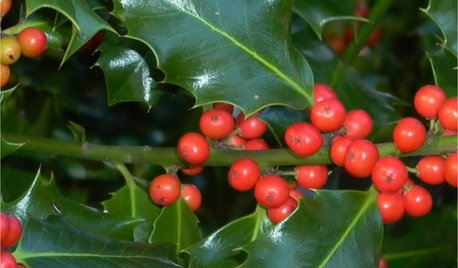

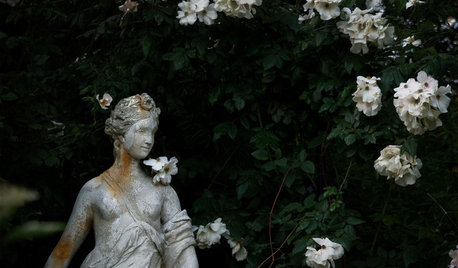



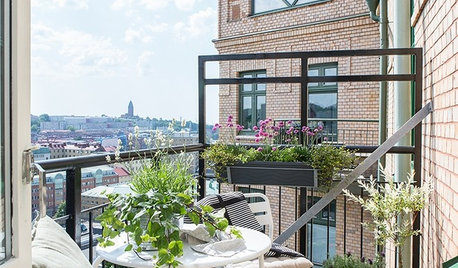

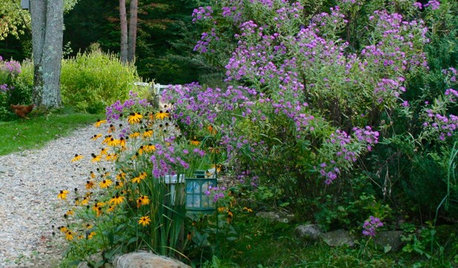



Cathy Kaufell